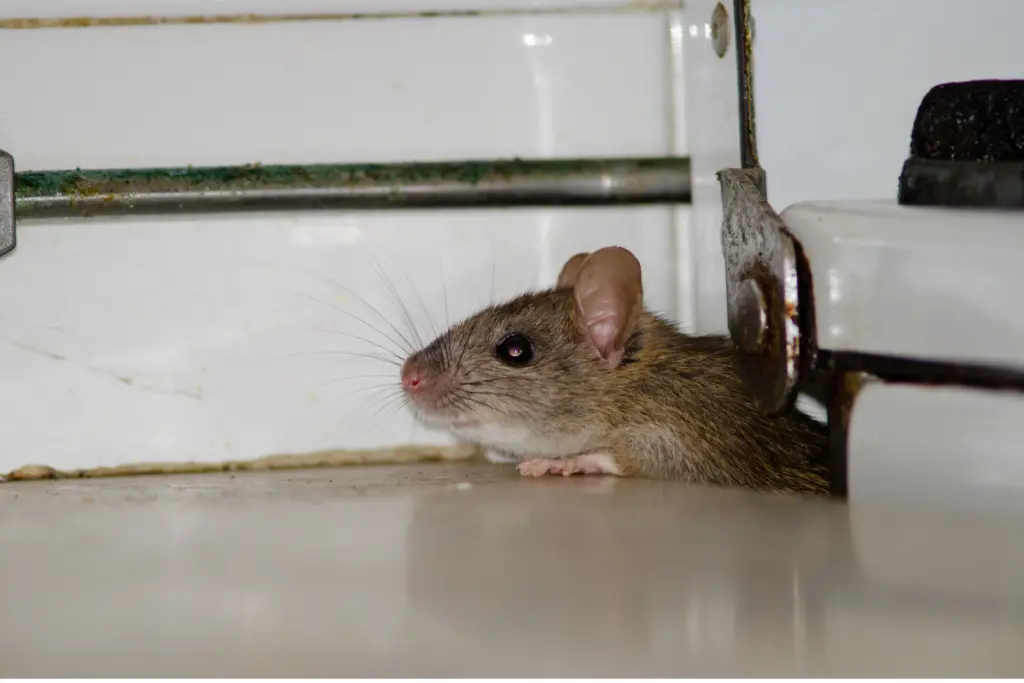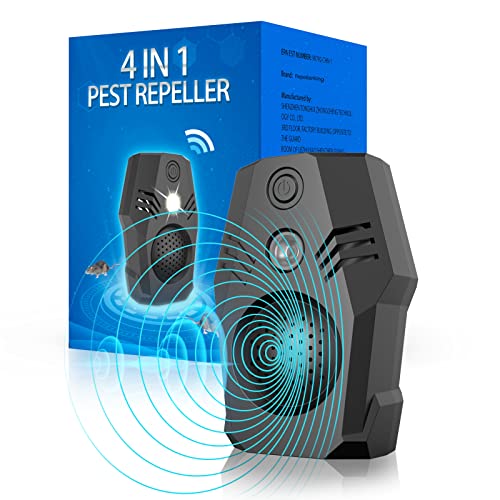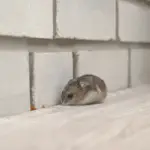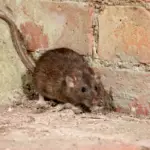Rats are a common household pest that can cause a lot of damage and pose health risks. These rodents can enter homes through small gaps and holes and can quickly multiply, causing an infestation.
Fortunately, there are several steps that homeowners can take to prevent rats from entering their homes.
One of the most effective ways to prevent rats from entering the home is to seal up any gaps or holes that they can use to gain entry.
Homeowners should inspect their home’s exterior and interior for any openings and seal them up with materials such as steel wool, caulk, or hardware cloth.
They should also ensure that doors and windows are properly fitted and that there are no gaps around them.
Another way to prevent rats from entering the home is to eliminate sources of food and water.
Homeowners should store food in airtight containers and ensure that their garbage is properly disposed of.
They should also fix any leaks and eliminate standing water around their home. By removing these attractants, homeowners can make their homes less appealing to rats.

Table of Contents
Sealing Entry Points
One of the most important steps in preventing rats from entering your house is sealing off any entry points.
Rats can squeeze through very small openings, so it’s crucial to be thorough in your search for possible entry points.
Doors
Doors are a common entry point for rats. Check for gaps between the door and the floor, as well as any gaps between the door and the frame.
Install door sweeps to close off any gaps between the door and the floor. Use weatherstripping to seal any gaps between the door and the frame.
Windows
Windows are another common entry point for rats. Check for gaps around the window frame and any cracks or holes in the glass.
Use caulk or weatherstripping to seal any gaps around the window frame. Replace any cracked or broken glass.
Vents
Vents are also a common entry point for rats. Check for gaps around any vents in your home, including dryer vents and attic vents.
Use mesh screens or wire mesh to cover any vents that are larger than 1/4 inch.
Cracks
Rats can enter through even the smallest cracks in your home’s foundation or walls. Check for any cracks in your home’s exterior and seal them with caulk or foam insulation.
Holes
Rats can also enter through holes in your home’s exterior. Check for any holes around pipes, cables, and wires.
Use steel wool or wire mesh to fill any holes larger than 1/4 inch. Seal the edges of the steel wool or wire mesh with caulk or foam insulation to prevent rats from gnawing through it.
By sealing off all possible entry points, you can greatly reduce the risk of rats entering your home.
It’s important to be thorough and check all areas of your home for possible entry points.
Removing Food and Water Sources
Preventing rats from entering the house requires removing their food and water sources.
Rats are attracted to homes that offer easy access to food and water. By eliminating these sources, homeowners can make their homes less attractive to rats.
Food Storage
Proper food storage is essential in preventing rats from entering the house. Store food in airtight containers made of glass, metal, or plastic.
Avoid using paper or cardboard containers as they are easy for rats to chew through.
Keep food stored in the pantry or kitchen cabinets, and avoid leaving food out on the counter.
Garbage Disposal
Garbage attracts rats, so it is important to dispose of it properly. Use a garbage can with a tight-fitting lid and keep it securely closed.
Do not leave garbage bags outside for an extended period. Place them in the garbage can as soon as possible.
Pet Food
Pet food is a common source of food for rats. Store pet food in airtight containers and avoid leaving it out overnight.
Do not leave pet food bowls outside as rats can easily access them. Clean up any spilled pet food immediately.
Water Sources
Rats need water to survive, so it is important to eliminate any standing water sources. Fix any leaky pipes or faucets.
Remove any standing water in the yard or garden, such as in bird baths or flower pots. Keep gutters and downspouts clear of debris to prevent water from pooling.
By removing food and water sources, homeowners can make their homes less attractive to rats.
Proper food storage, garbage disposal, pet food management, and elimination of standing water sources are all important steps in preventing rats from entering the house.
Using Rat Repellents
Rat repellents are a popular way to deter rats from entering homes. There are many types of rat repellents available, including natural and chemical options.
Here are some of the most effective rat repellents:
Peppermint Oil
Peppermint oil is a natural rat repellent that can be used both indoors and outdoors. Rats find the scent of peppermint oil overwhelming and will stay away from areas where it is present.
To use peppermint oil as a rat repellent, simply soak cotton balls in the oil and place them around the home, especially in areas where rats are known to enter.
- Naturally Safe for People and Pets - Smells Good Too!
- Extra-Concentrated Strength for Long-Lasting Protection
- Locally-Sourced, High-Grade Peppermint from the Pacific Northwest
- Active Ingredient: Pure Origin Peppermint Essential Oil
- Drives Rodents Out and Keeps Them Away - Humane and Effect
Prices pulled from the Amazon Product Advertising API on:
Product prices and availability are accurate as of the date/time indicated and are subject to change. Any price and availability information displayed on [relevant Amazon Site(s), as applicable] at the time of purchase will apply to the purchase of this product.
Mothballs
Mothballs are another effective rat repellent. They contain a chemical called naphthalene, which is toxic to rats.
To use mothballs as a rat repellent, simply place them in areas where rats are known to enter, such as attics, basements, and crawl spaces.
- EFFECTIVE RODENT REPELLENT - Made with a combination of essential oils like Castor oil, Rosemary oil and Geranium oil, the mouse repellent give off a long-lasting scent of essential oils, quickly repelling rodents from your property and prevent them from chewing on wires and nesting in your house.
- LONG LASTING PROTECTION- These rodent repellent deliver a long lasting scant, which is pleasant to humans but offensive to rats and mice.The odor can last about 30-90 days and is effective to repel the rodents.
- SAFE & EFFECTIVE - Made with a combination of essential oils, the mice repellent pouch is safe for human and pet. You are being protected in a safe and eco-friendly way. Safe for human, pets and plants when used as directed.
- EASY TO USE - Simply place a rat repellent in any enclosed areas to get rid of rodents.Simply place one pouch for every 125 sq. feet.
- MULTI USE - It is perfect for closets, pantries, basements/attics, farm equipment, autos, trucks, vehicles, RV, tractors, sheds, barns, garages, storage units, boats and any enclosed are
Prices pulled from the Amazon Product Advertising API on:
Product prices and availability are accurate as of the date/time indicated and are subject to change. Any price and availability information displayed on [relevant Amazon Site(s), as applicable] at the time of purchase will apply to the purchase of this product.
Ammonia
Ammonia is a strong-smelling chemical that rats find unpleasant. To use ammonia as a rat repellent, simply soak rags in ammonia and place them in areas where rats are known to enter.
Be sure to wear gloves and a mask when handling ammonia, as it can be harmful to humans.
Ultrasonic Devices
Ultrasonic devices emit high-pitched sounds that rats find irritating. These devices are typically plugged into an electrical outlet and can cover a large area.
While ultrasonic devices are effective at deterring rats, they can also be expensive and may not work in all situations.
It’s important to note that while rat repellents can be effective at deterring rats, they are not a foolproof solution.
It’s important to also take steps to seal up any entry points that rats may be using to enter the home, such as gaps in the foundation or holes in the roof.
By combining rat repellents with preventative measures, homeowners can effectively keep rats out of their homes.
- SAFE PEST CONTROL: This new device uses environmentally friendly frequency conversion ultrasonic waves to interfere with the central nervous system, taste, hearing and visual nervous systems of pests. Without killing critter and no poison, no more need to prepare various mouse poison, mouse traps, mouse mats, rat glue traps, roach motels, cockroach bait, rat poison, raccoon blocker and insect sprays. Get rid of annoying insects.
- MULTI FUNCTIONS: The rat repellent with 4 modes can meet all your needs. Different light colors represent different functions, and you can choose the appropriate mode to use according to the environment. For example, you can choose silent mode in the bedroom. Using the rodent repellent to repel critters is a humane pest control solution.
- EASY TO USE: Easy to install and easy to carry, just plug it vertically into a wall socket 11.8 inch - 23.6 inch above the ground. And adjust the mode according to the needs of the environment to achieve the best repelling effect. No poison and harmful to human and pets.
- EFFECTIVE COVERAGE AREA: The effective coverage is wide. The maximum effective range of ultrasonic mouse repellent is 800~1600 sq. ft in one single room. If there are multiple rooms in your house, it is recommended to install one per room to protect your home more effectively.
- WIDE APPLICATION: The product works long term and you will see noticeable improvement after 4 weeks. Effective deterrent against rodent infestation. Suitable for attic, house, home, indoor bedroom, warehouses, storage rooms, shops, offices, restaurants, classrooms, hotels, hospitals, garages, e
Prices pulled from the Amazon Product Advertising API on:
Product prices and availability are accurate as of the date/time indicated and are subject to change. Any price and availability information displayed on [relevant Amazon Site(s), as applicable] at the time of purchase will apply to the purchase of this product.
Trapping Rats
Trapping rats is an effective way to eliminate them from your home. There are different types of traps available in the market, including snap traps, glue traps, and live traps.
Each trap has its own benefits and drawbacks, and it is up to the homeowner to choose the one that suits their needs.
Snap Traps
Snap traps are the most common type of rat trap. They work by using a spring-loaded bar that snaps shut when the rat takes the bait.
These traps are easy to set up and are very effective. However, they can be dangerous to use, especially if you have pets or children in the house.
To use a snap trap, place the bait on the trigger and set the trap in an area where you have seen rat activity. Check the trap regularly, and dispose of any dead rats.
- Designed for Rats - Traps rats with a simple, straightforward design which offers a clean, instant kill
Prices pulled from the Amazon Product Advertising API on:
Product prices and availability are accurate as of the date/time indicated and are subject to change. Any price and availability information displayed on [relevant Amazon Site(s), as applicable] at the time of purchase will apply to the purchase of this product.
Glue Traps
Glue traps are another type of rat trap that works by using a sticky substance to trap the rat. These traps are easy to use and are very effective at catching rats.
However, they can be inhumane, as the rat can suffer for hours or even days before dying.
To use a glue trap, place it in an area where you have seen rat activity. Check the trap regularly, and dispose of any trapped rats.
It is important to note that glue traps should not be used if you have pets in the house, as they can also get stuck on the trap.
- 🐭【Sturdy & Larger Tray】We design larger and heavier sturdy trays to capture larger rodents. Its heavyweight prevents rats and mice from dragging this rat trap when they try to escape. Using our glue traps for mice and rats will help you achieve first class results!
Prices pulled from the Amazon Product Advertising API on:
Product prices and availability are accurate as of the date/time indicated and are subject to change. Any price and availability information displayed on [relevant Amazon Site(s), as applicable] at the time of purchase will apply to the purchase of this product.
Live Traps
Live traps are a humane way to catch rats. These traps work by using a bait to lure the rat into a cage.
Once the rat is inside, the door closes, trapping the rat inside. These traps are easy to use and are very effective at catching rats without harming them.
To use a live trap, place the bait inside the cage and set the trap in an area where you have seen rat activity. Check the trap regularly, and release any trapped rats far away from your home.
In conclusion, trapping rats is an effective way to eliminate them from your home. Each type of trap has its own benefits and drawbacks, and it is up to the homeowner to choose the one that suits their needs.
It is important to use traps safely and responsibly, and to dispose of any dead rats properly.
- 【32 X 12.5 X 12 Cage Trap】-- ZENY live animal trap cage is good ideal designed for trapping raccons, opossums, cats, rabbits, and other similar-sized undesired animals, relocate or rescue streetwise wild animals. Solid door and large handle guard offers protection during transportation.
Prices pulled from the Amazon Product Advertising API on:
Product prices and availability are accurate as of the date/time indicated and are subject to change. Any price and availability information displayed on [relevant Amazon Site(s), as applicable] at the time of purchase will apply to the purchase of this product.
Professional Help
Sometimes, despite all the efforts, rats can still find their way into a home. In such cases, it may be necessary to call in a professional pest control company.
When to Call a Professional
If the rat infestation is severe or if the homeowner is unable to locate the entry points, it is best to call a professional.
Additionally, if the homeowner has tried multiple methods and has not been successful in getting rid of the rats, it is time to call for professional help.
Choosing a Pest Control Company
When selecting a pest control company, it is important to choose one that is licensed and insured. The company should also have a good reputation and be experienced in dealing with rat infestations.
Before hiring a pest control company, the homeowner should ask for references and read reviews from other customers.
The company should also provide a detailed estimate of the work to be done, including the methods to be used, the cost, and the timeline for completion.
It is also important to ask the pest control company about their approach to rat control. The company should use safe and humane methods, and should not use toxic chemicals that may harm other animals or the environment.
In conclusion, while prevention is the best way to keep rats out of the home, sometimes calling a professional pest control company is necessary.
By choosing a reputable and experienced company, homeowners can get rid of rats quickly and safely.
Conclusion
In conclusion, taking proactive measures to prevent rats from entering your house is essential for maintaining a clean and safe living environment.
By implementing strategies such as sealing entry points, proper sanitation, and removing attractants, you can effectively deter rats and minimize the risk of infestation.
Remember, early prevention is key to avoiding the potential health hazards and property damage associated with these rodents.
Stay vigilant and take necessary precautions to protect your home and loved ones from rat intrusion.
- How to Build a Planter Box for Bamboo: A Step-by-Step Guide

- Can Robotic Lawnmowers Handle Steep Slopes?

- Do You Need a Specific Lawn for a Robotic Lawnmower? Expert Advice

- Are Robotic Lawnmowers Safe for Pets and Children? Safety Features of Robotic Lawnmowers

- Why Use Robotic Lawnmowers? Advantages of Using a Robotic Lawnmower

- Is the GARDENA SILENO City 300 Cordless or Corded? A Clear Answer




















